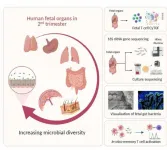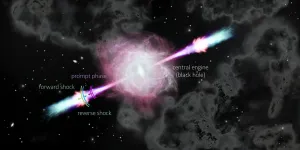(Press-News.org) In an international study published by the journal Environment International, the University of Surrey led an international team of air pollution experts in monitoring pollution hotspots in 10 global cities: Dhaka (Bangladesh); São Paulo (Brazil); Guangzhou (China); Medellín (Colombia); Cairo (Egypt); Addis Ababa (Ethiopia); Chennai (India); Sulaymaniyah (Iraq); Blantyre (Malawi); and Dar-es-Salaam (Tanzania).
Surrey's Global Centre for Clean Air Research (GCARE) set out to investigate whether the amount of fine air pollution particles (PM2.5) drivers inhaled is connected to the duration drivers spend in pollution hotspots and socio-economic indicators such as gross domestic product (GDP).
Across all the cities in the study, researchers found that drivers only needed to spend a short amount of time in high-pollution hotspots to inhale a significant amount of PM2.5 particles. For example, drivers in Guangzhou and Addis Ababa spent 26 and 28 per cent of their commute in hotspot areas, which contributed to 54 and 56 per cent of the total amount of air pollution inhaled on their trip.
The researchers found that the cities where drivers were exposed to the highest levels of PM2.5 pollution - Dar-es-Salaam, Blantyre and Dhaka - also experienced higher death rates per 100,000 commuting car population per year. The low PM2.5 levels in Medellín, São Paulo and Sulaymaniyah corresponded with very low death rates.
The international study assessed economic losses by measuring a city's death rate caused by PM2.5 car exposure against its GDP per capita. It found that, for most cities, lower GDP linked directly to more significant economic losses caused by in-car PM2.5 exposure - with Cairo and Dar-es-Salaam being impacted the most (losses of 8.9 and 10.2 million US dollars per year, respectively).
The team also found that, except for Guangzhou, cities with higher GDP per capita have less hotspot areas during an average route trip, thus decreasing the risk to drivers.
Professor Prashant Kumar, Principal Investigator of CArE-Cities Project, Associate Dean (International) and Founding Director of GCARE at the University of Surrey, said: "Our global collaborative project has confirmed that air pollution disproportionately affects developing countries. Many countries are caught in a vicious cycle where their low GDP leads to higher pollution exposure rate for drivers, which leads to poorer health outcomes, which further damages the economy of those cities. This is discouraging news - but it should galvanise the international community to find and deploy measures that mitigate the health risks faced by the world's most vulnerable drivers."
Professor Shi-Jie Cao, a collaborative partner from the Southeast University, said: "If we are ever to make a world where clean air is available to all, it will take a truly global collaborative effort - such as CArE-Cities. We hope to continue to work closely with Surrey and other global partners, sharing knowledge and expertise that will make a cleaner future a reality."
Professor Adamson Muula, a collaborative partner from formerly University of Malawi and now Head of Public Health at the Kamuzu University of Health Sciences (KUHeS), said: "If developing countries are to not be left behind in the struggle against air pollution and climate change, it is important that we build the capacity and knowledge to gather on-the-ground data. This project is a small but a significant step in the right direction for Malawians; a direction which will lead to better decisions and cleaner air for Malawi."
INFORMATION:
Note to editors
The study was part of the Clean Air Engineering for Cities (CArE-Cities) project and builds upon our previous work around car exposure. CArE-Cities is a seed funding project awarded by the University of Surrey under the Research England's Global Challenge Research Funds. CArE-Cities involves 11 Development Assistance Committee (DAC) listed countries and aspires to bring cleaner air to cities by building a knowledge exchange platform. Its activities include joint workshops, researchers exchange and pilot studies to address urban development and health impact assessment agendas in ODA countries.
Reference
Kumar, P., Hama, S., Abbass, R. A., Nogueira, T., Brand, V. S., Abhijith, K. V., de Fatima Andrade, M., Asfaw, A., Aziz, K. H., Cao, S. J., El-Gendy, A., Khare, M., Muula, A. S., Nagendra, S. M. S., Ngowi, A. V., Omer, K., Olaya, Y., Salam, A., 2021. Potential health risks due to in-car aerosol exposure across ten global cities. Environment International 155, 106688. Online link: https://doi.org/10.1016/j.envint.2021.106688
2 June 2021, Singapore - The human fetal immune system begins to develop early during gestation, however, factors responsible for fetal immune-priming remain elusive. Using multiple complementary approaches, Dr Florent Ginhoux from A*STAR's Singapore Immunology Network (SIgN), Professor Jerry Chan from KK Women's and Children's Hospital (KKH), Professor Salvatore Albani from the SingHealth Duke-NUS Translational Immunology Institute, with collaborators from Cambridge University explored potential exposure to microbial agents in-utero. The team identified live microbes across fetal organs that stimulate activation of fetal T-cells during the second trimester of gestation. Study published in scientific journal, Cell, on 24 June 2021.
The team profiled microbes ...
Do you like the thick brush strokes and soft color palettes of an impressionist painting such as those by Claude Monet? Or do you prefer the bold colors and abstract shapes of a Rothko? Individual art tastes have a certain mystique to them, but now a new Caltech study shows that a simple computer program can accurately predict which paintings a person will like.
The new study, appearing in the journal Nature Human Behaviour, utilized Amazon's crowdsourcing platform Mechanical Turk to enlist more than 1,500 volunteers to rate paintings in the genres of impressionism, cubism, abstract, and color field. The volunteers' answers were fed into a computer program and then, after this training period, the computer ...
Chatbots hold promise for dementia patient or caregiver support, but are still in their infancy, finds a paper published in the Journal of Medical Internet Research. None of the interactive digital apps tested by medical researchers and a computer scientist performed well on all testing criteria, and all the apps contained linguistic biases and usability challenges. The authors conclude that until developers produce evidence-based chatbots that have undergone end user evaluation it will be hard to evaluate their potential to adequately educate and support dementia patients and their caregivers.
"Dementia care is complex and no two cases of dementia are alike. Chatbots have the potential of providing ...
Ozone is a pollutant at ground level, but very high in the atmosphere's "ozone layer," it absorbs damaging ultraviolet radiation. Past studies have examined ozone levels in the Southern Hemisphere, but little is known about levels of the molecule in Antarctica over long periods. Now, researchers reporting in ACS' Environmental Science & Technology have analyzed more than 25 years of Antarctic data, finding that concentrations near the ground arose from both natural and human-related sources.
Ozone gas has a sharp or acrid scent that sometimes accompanies smog or summer storms. It forms when sunlight ...
Microplastic pollution of waterways has become a huge concern, with the tiny pieces of plastic entering food webs and potentially having harmful effects on animals and people. In addition, microplastics can act as breeding grounds for antibiotic-resistant bacteria. Now, researchers reporting in Environmental Science & Technology have analyzed antibiotic-resistance genes (ARGs) on five types of microplastics at different locations along the Beilun River in China, finding much higher abundances in urban than rural regions.
In rivers, major sources of microplastics include textile fibers from laundering, water bottle fragments, and films from bags and wrappers. Also prevalent in ...
An international team of scientists, led by astrophysicists from the University of Bath in the UK, has measured the magnetic field in a far-off Gamma-Ray Burst, confirming for the first time a decades-long theoretical prediction - that the magnetic field in these blast waves becomes scrambled after the ejected material crashes into, and shocks, the surrounding medium.
Black holes are formed when massive stars (at least 40 times larger than our Sun) die in a catastrophic explosion that powers a blast wave. These extremely energetic events drive out material at velocities ...
Researchers using the Atacama Large Millimeter/submillimeter Array (ALMA) discovered a titanic galactic wind driven by a supermassive black hole 13.1 billion years ago. This is the earliest-yet-observed example of such a wind to date and is a telltale sign that huge black holes have a profound effect on the growth of galaxies from the very early history of the Universe.
At the center of many large galaxies hides a supermassive black hole that is millions to billions of times more massive than the Sun. Interestingly, the mass of the black hole is roughly proportional to the mass ...
The old cousins of the common woodlice were crawling on Irish land as long as 360 million years ago, according to new analysis of a fossil found in Kilkenny.
The research, published today (00.01 Wednesday 16 June) in the science journal Biology Letters, used state-of-the-art modern imaging technology to create a new picture of the Oxyuropoda - a land-based creature larger than the modern woodlice - using a fossil found in Kiltorcan, Co Kilkenny in 1908.
Lead researcher Dr Ninon Robin, a postdoctoral researcher at University College Cork's (UCC) School of Biological, Earth and Environmental Sciences said that their work advances science's understanding of when land-dwelling species of crustaceans roamed the earth, and what they looked like.
Dr Robin said:
"Woodlice, ...
Québec produces more strawberries than any other Canadian province. Strawberries are delicate and difficult to keep fresh. In response to this challenge, Monique Lacroix, a professor at at the Institut national de la recherche scientifique (INRS), and her team have developed a packaging film that can keep strawberries fresh for up to 12 days. The team's findings on how this film protects against mould and certain pathogenic bacteria have been published in Food Hydrocolloids.
The innovative film is made of chitosan, a natural molecule found in shellfish shells. This food industry by-product contains key antifungal properties ...
Thirty state-of-the-art IPCC-climate models predict dramatically different climates for the Northern Hemisphere, especially Europe. An analysis of the range of responses now reveals that the differences are mostly down to the individual model's simulations of changes to the North Atlantic ocean currents and not only - as normally assumed - atmospheric changes. The work, by Katinka Bellomo, National Research Council of Italy, Institute of Atmospheric Sciences and Climate, and colleagues is published today in Nature Communications and is part of the European ...






